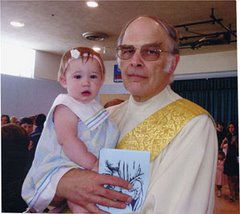Mark 5:21 - 43
Is this just another story about how
Jesus can heal people? Or is there something more going on here.
It's peculiar, in a way, because as you can see in your missalette,
we could just tell the story of the little girl and leave out that
thing in the middle about the woman with the bleeding problem. Are
these really two stories or is it one. Mark means for his audience
to consider the two events together. Unfortunately, we can't ask
Mark what he was talking about, but there have been many people who
saw something more profound here.
Father Ronald Rolheiser has perhaps
one of the most unusual ideas. He says the two women in this
situation have one thing in common: they cannot bear children, they
cannot become pregnant. A woman who is having a constant hemorrhage
would be unapproachable. Even today, Orthodox Jews are not supposed
to engage in marital relations if there is any bleeding going on.
And the little girl, whose age is specified as twelve, is one year
short of the traditional age when she can become engaged. So neither
can become pregnant, neither can give life. And Jesus restores both
to this possibility. Maybe the lesson here is that if we want to be
spiritually fertile we have to be touched by Jesus; only through a
relationship with him can be bring others to him.
But I just mention that because I
think it's interesting. Another way to look at the story is this.
It is all about Jesus' ongoing ministry; it is about fear and faith.
It is, in fact, all about God, since Jesus told us that if you see
Him, you have seen the father.
Jarius, the first character, is an
important man. Given his position in town, he would not naturally be
a follower of Jesus; in fact as we see elsewhere, officials in the
Jewish religion didn't have much use for Jesus. But Jarius' daughter
is dying and he puts himself out; it says he “fell at his feet” –
got down on his knees – and begged Jesus to save his daughter. He
must have feared the reaction of his fellow pharisees and scribes and
the proper members of his synagogue, but he overcame that fear and
had faith. And Jesus responds with a ministry of presence – he
goes off with him.
The second character is the woman.
Mark in a few short words shows us how desperate she is. The
hemorrhage makes her an outcast; she is unclean, and what she touches
is unclean. If she sits on a chair, you can't use the chair; if she
lies on a bed, same thing. It was kind of like being a leper. And
she's done everything she can to get rid of her affliction, to the
point of having nothing left. Not only is she unclean, she is broke
and probably friendless. So when she reaches out to touch Jesus'
garment, she is doing something unlawful; she is making him unclean.
You could get stoned for that. But she overcomes her fear, and has
faith, and Jesus responds with a ministry of promise. She feels that
she has been healed, and Jesus tells her that it is her faith that
healed her and accepts her back into society by calling her
“daughter”. And if we were to read the Greek, it says something
like “Go in peace and be cured permanently”. Jesus promises that
she won't be troubled by this again.
The third character is the little
girl. She doesn't have a speaking part. But if she's like twelve
year old girls I've known, and I've known many, she probably spoke a
great deal. And she didn't understand what was happening – what
child would? But as she felt the life going out of her she must have
felt fear, fear of the unknown – and it was up to her parents to
have the faith. After they have been told she has died, and that
they should not bother the teacher, Jesus tells them not to fear, but
to have faith. And the parents continue with Jesus to the little
girl's bedside; they overcome their fear, they have faith. And Jesus
responds with a ministry of power. He takes the little girl by the
hand – he's already unclean, after all, so he might as well touch a
dead body – and Mark quotes Jesus here, using the actual Aramaic
words that Jesus spoke “Talitha kum”. And she rises. Mark uses
the same word he will use when he describes Jesus rising, something
his readers would not have missed. And the only other time Jesus'
actual words are quoted are when Mark describes Jesus passion and he
calls out in aramaic, Eloi, Eloi, lama sabacthani”.
Now it would be nice if Jesus were
walking among us in the flesh, healing the terrible things that
happen to people, the things that no one deserves. How I wish he
would heal the people I see slipping away into Alzheimer's disease;
how I used to pray that he would cure this patient with cancer, that
one with leukemia. And if Jesus were walking among us, no child
would be cut off from life, never having an opportunity to live his
potential.
Mark's readers were just like you and
I in essential respects. They were Christians living in a pagan
society, and so are we. They got in trouble for opposing the spirit
of the times, and so do we when we oppose abortion or physician
assisted suicide, or try to defend traditional marriage, or nowadays,
want some orderly way to deal with refugees from other countries
while protecting what we value about our country. There are many
ways you can get in trouble just like Mark's readers. All those
possibilities make us fear, and fear can lead to inaction. But Jesus
shows us that he is with us, he holds out the promise that in the end
things will turn out right; and that he has the power to bring about
the kingdom of God, where things will be on earth as they are in
heaven.
And that should make us lose our fear
and strengthen our faith and desire to be partners in making a new
world where God;'s will is done.



































